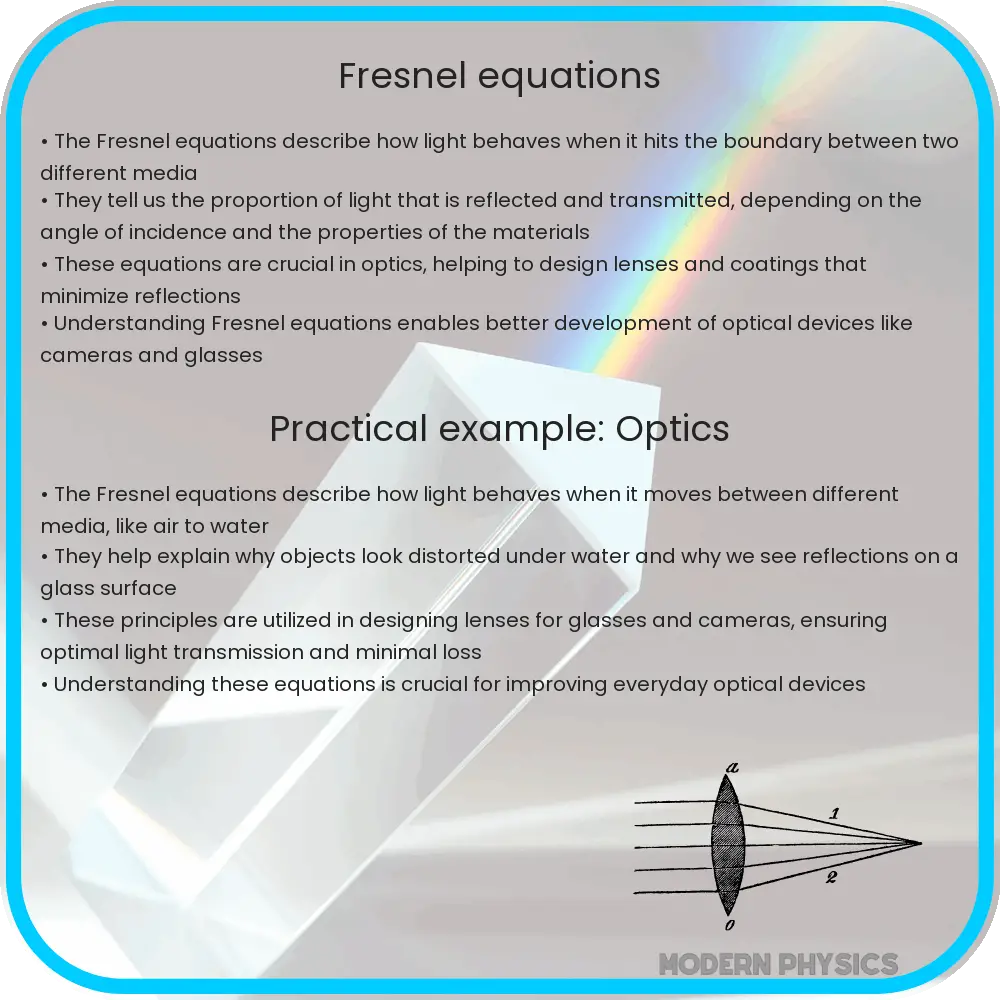Explore the Fresnel Equations’ role in optics, covering light reflection, refraction, and practical applications in technology and design.

Understanding Fresnel Equations in Optics
The Fresnel Equations are fundamental to the field of optics, providing a detailed description of light behavior at the interface between two media. These equations, named after the French engineer and physicist Augustin-Jean Fresnel, describe the reflection and refraction of light when it encounters the boundary between two different optical media. The Fresnel Equations are crucial for understanding phenomena such as the reflective properties of surfaces, the efficiency of lenses, and the transmission of light through materials.
Light Reflection and Refraction Basics
Reflection and refraction are two principal phenomena that occur when light waves travel from one medium into another with a different refractive index. Reflection refers to the bouncing back of light rays into the original medium, while refraction describes the bending of light rays as they pass into the second medium. The law of reflection states that the angle of incidence equals the angle of reflection. In contrast, Snell’s Law, which governs refraction, relates the angles of incidence and refraction to the refractive indices of the two media according to the equation \(n_1 \sin(\theta_1) = n_2 \sin(\theta_2)\), where \(n_1\) and \(n_2\) are the refractive indices, and \(\theta_1\) and \(\theta_2\) are the angles of incidence and refraction, respectively.
The Role of Fresnel Equations
The Fresnel Equations take these concepts further by quantifying the fraction of the incident light that is reflected and refracted at the boundary. They differentiate between light that is polarized parallel (\(s\)-polarized) and perpendicular (\(p\)-polarized) to the plane of incidence. The equations are expressed as ratios of the electric field amplitudes of the reflected and refracted waves to the incident wave, which depend on the polarization of the incident light and the angles of incidence and refraction.
- Reflection Coefficient for \(s\)-polarized Light (\(R_s\)): This coefficient determines the ratio of the reflected wave’s amplitude to that of the incident wave for light polarized perpendicular to the plane of incidence.
- Reflection Coefficient for \(p\)-polarized Light (\(R_p\)): Similarly, this coefficient measures the amplitude ratio for light polarized parallel to the plane of incidence.
The Fresnel Equations illustrate how the reflectivity of a surface varies with the angle of incidence and the polarization of the light, leading to phenomena such as the Brewster angle, at which no light is reflected for \(p\)-polarized light.
Practical Applications and Implications
The Fresnel Equations have wide-ranging applications across various fields within and beyond optics. In the design of anti-reflective coatings for glasses and lenses, these equations help in optimizing the layers to minimize reflection and maximize transmission. Similarly, in the field of solar energy, they are used to enhance the efficiency of solar panels by reducing reflection losses. Furthermore, the principles underlying the Fresnel Equations are instrumental in the development of fiber optic technology, where controlling light reflection and refraction is key to efficient signal transmission.
Understanding Total Internal Reflection
A critical application of the Fresnel Equations is in explaining the phenomenon of total internal reflection (TIR), which occurs when light attempts to move from a medium with a higher refractive index to one with a lower refractive index at an angle greater than the critical angle. The equations predict a 100% reflection coefficient for \(p\)-polarized light under these conditions, a principle exploited in fiber optic cables to confine light within the core without loss.
Impact on Modern Optics and Technologies
The Fresnel Equations also play a pivotal role in the creation of holograms and the study of optical phenomena such as the color shifts seen in thin films (e.g., oil on water or soap bubbles). These applications underscore the equations’ significance in both fundamental research and practical technological innovations.
Conclusion
The Fresnel Equations represent a cornerstone of optical science, offering profound insights into the behavior of light at the boundary between different media. By quantifying how light is reflected and refracted, these equations enable the precise analysis and design of optical systems. From enhancing the efficiency of solar panels to the development of advanced fiber optics, the impact of the Fresnel Equations extends across numerous scientific and engineering disciplines. As we continue to explore the complexities of light and its interactions, the Fresnel Equations remain an essential tool in the ongoing advancement of optical technologies and the exploration of electromagnetic theory.
